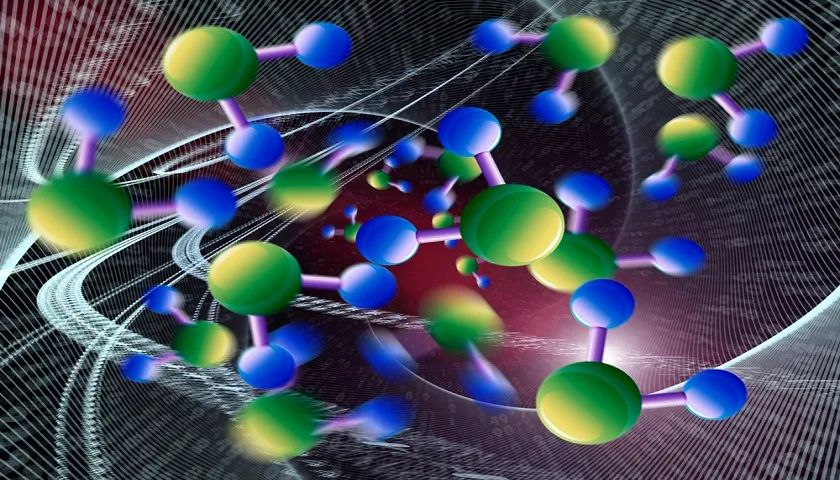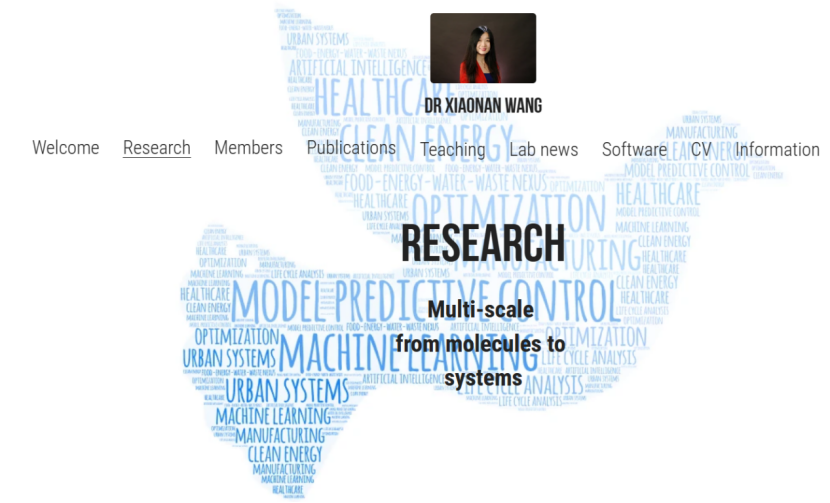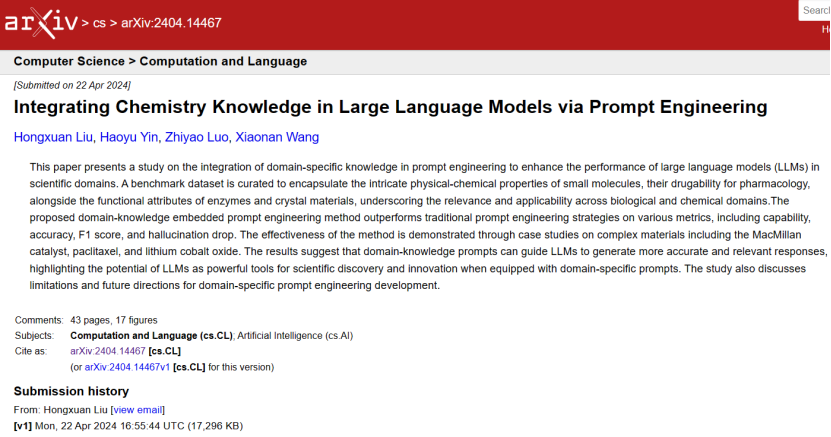 Technology peripherals
Technology peripherals
 AI
AI
 From material design and synthesis to catalyst innovation and carbon neutrality, Tsinghua Wang Xiaonan's team explores the frontier and implementation of 'AI+ materials”
From material design and synthesis to catalyst innovation and carbon neutrality, Tsinghua Wang Xiaonan's team explores the frontier and implementation of 'AI+ materials”
From material design and synthesis to catalyst innovation and carbon neutrality, Tsinghua Wang Xiaonan's team explores the frontier and implementation of 'AI+ materials”

In today's era of rapid technological development, the research and development of new materials has become a driving force A key force in scientific progress and the industrial revolution. From energy storage to information technology to biomedicine, the design, synthesis and functional characterization of innovative materials are the cornerstones of breakthroughs in these fields. The research and development of new materials has shown a trend of breakthroughs in many fields. In terms of energy storage, researchers are working to develop more efficient and safer battery materials to meet the storage needs of renewable energy. At the same time, the advancement of information technology has also prompted materials scientists to
With the continuous advancement of artificial intelligence (AI) technology, its application in new materials research has opened a new research paradigm and become a new research paradigm that transcends the traditional R&D model. qualitative productivity. Especially in the design, synthesis and characterization of materials, the assistance of AI has greatly improved research efficiency and accuracy.

The prompt project embedding domain knowledge promotes the application of LLM in the scientific field
Wang Xiaonan’s team. We have long valued generative AI, especially the vertical application of large language models (LLM) in the scientific field. Currently, large language models have proven their great potential in processing and analyzing large-scale data sets in multiple general fields. However, these models often require more fine-tuning to achieve optimal results when faced with the complexity of specific vertical domains. Prompt engineering refers to optimizing and guiding the output of large language models through carefully designed prompts or guidance statements, so that they can better adapt to and handle problems in specific fields. Recently, Wang Xiaonan’s team developed a hint engineering method to enhance its performance in the scientific field by integrating chemical domain knowledge in large language models.

Intelligent atom robot probe technology, Quantum materials can be efficiently manufactured with atomic precision
Recently, the intelligent atomic robot probe technology jointly developed by Wang Xiaonan’s team and Associate Professors Lu Jiong and Chun Zhang of the National University of Singapore provides a typical demonstration of this paradigm change. By combining AI with probe chemistry technology, atomically precise synthesis of carbon-based quantum materials was achieved.

This work proposes a conceptual system of the Chemist's Intuitive Atomic Robot Probe (CARP) to prepare and characterize open-shell magnetic nanographene at the single-molecule level to achieve its π Precise construction of electronic topology and spin configurations.
CARP is driven by a series of deep neural networks trained by the experience and knowledge of surface chemists. It can realize the independent synthesis of molecular materials and effectively obtain valuable hidden information from the experimental training database, providing a comprehensive understanding of exploration. Provide important support for theoretical simulations of chemical reaction mechanisms.
The related research was titled "Intelligent synthesis of magnetic nanographenes via chemist-intuited atomic robotic probe" and was published in "Nature Synthesis" on February 29, 2024.

Professor Michael Gottfried, University of Marburg, Germany At the same time, he wrote an article "Single-molecule chemistry with a smart robot", which highly praised this work as a leading example of the combination of AI and nanotechnology.
「Stands out as a pioneering example, showcasing remarkable advancements in controlling molecules at the limit of single chemical bonds.」
This study It not only overcomes the problems of poor reaction selectivity and low production efficiency in traditional surface-assisted synthesis, but also transforms complex chemical processes through deep neural networks, allowing the synthesis precision of single-molecule operations to reach an unprecedented level.
Active learning is combined with first-principles calculations for catalyst screening and design
In recent years, Wang Xiaonan’s team has established a series of chemical materials design, synthesis and characterization evaluation The machine learning framework builds a high-throughput catalyst screening model based on active learning strategies, and simultaneously optimizes process parameters to achieve multi-scale precise design optimization. To address the difficult problem of integrating complex data and knowledge from the atomic level to the macro level, multi-scale digital twins and low-carbon intelligent connected systems are established.
In addition to the above-mentioned breakthroughs in basic research, a series of important applications for the main battlefield of the national economy have also been developed.
In terms of the design of catalysts for the selective hydrogenation of low-carbon alkynes, we collaborated with the team of Professor Duan Xuezhi of East China University of Science and Technology to achieve precise control of the Ni active site structure at the atomic scale, which not only provided orientation for the target reaction path control strategies, and promote the wide application of non-precious metal catalysts in the petrochemical industry.

The research team proposed a research method that combines an active learning framework based on Bayesian optimization with DFT calculations to determine the energy barrier difference between ethylene desorption and its further hydrogenation. As selectivity descriptors, a workflow for automated catalyst high-throughput screening was constructed for predicting high-performance Ni-based intermetallic compounds for the selective hydrogenation of acetylene.
Subsequently, 15 high-performance Ni-based intermetallic compounds were quickly screened from more than 3000 candidate Ni-based intermetallic compounds as potential alkyne hydrogenation catalysts, and DFT calculations were used to further verify the predictions of the ML model. accuracy, the recommended NiIn catalyst was finally determined as the optimal candidate catalyst for further experimental verification.
Catalytic reaction performance evaluation shows that: when the acetylene and propyne conversion rate of the NiIn intermetallic compound catalyst is 100%, the ethylene and propylene selectivity is as high as 97.0%, which is significantly higher than the reference catalyst, demonstrating the power of artificial intelligence. Huge potential in catalyst design.
Relevant results were published online in the Journal of the American Chemical Society under the title "Atomic Design of Alkyne Semihydrogenation Catalysts via Active Learning". A series of catalysts discovered are also being used in industry Enlarging and transforming.

Paper link: https://pubs.acs.org/doi/full/10.1021/jacs.3c14495
AI Carbon Neutrality: Accelerating High-Performance Biochar Development, Improving CO₂ Capture Capacity
Wang Xiaonan’s team has long been paying attention to the field of AI carbon neutrality. In terms of research on carbon dioxide capture with biochar, we have co-founded the Pacific Rim University Alliance Sustainable Waste Management Project with collaborators from many countries to develop low-carbon, zero-carbon, and negative-carbon technologies to mitigate climate change while promoting sustainable waste management.
In view of the challenges of traditional biochar synthesis process being time-consuming, laborious and poor in accuracy, Wang Xiaonan’s team designed a customized active learning strategy that can guide and accelerate the synthesis of biochar and improve its adsorption of carbon dioxide. Ability.
This framework learns experimental data, recommends the best synthesis parameters, verifies the learning effect through experiments, and iteratively uses experimental data for subsequent model training and re-validation, thereby establishing a complete closed loop.
The research team ultimately synthesized 16 engineered biochar samples with specific properties, nearly doubling the amount of carbon dioxide absorbed in the final round. This study demonstrates a data-driven workflow that accelerates the development of high-performance engineered biochar materials.
The relevant results were published in the authoritative environmental journal "Environmental Science & Technology" under the title "Active Learning-Based Guided Synthesis of Engineered Biochar for CO₂ Capture" and was selected as the cover paper.

Paper link: https://pubs.acs.org/doi/full/10.1021/acs.est.3c10922
Open up new avenues for scientific exploration and provide practical applications Strong Support
This series of research work is supported by projects such as the "New Generation Artificial Intelligence National Science and Technology Major Project" for which Professor Wang Xiaonan serves as the project leader and chief scientist.
Relevant results not only open up new avenues for scientific exploration, but also provide strong support for practical applications, especially showing great potential in promoting sustainable development and responding to global issues.
With the rapid progress of AI technology, its application prospects in intelligent chemical engineering, new material development, new energy technology and other fields are very broad, and will produce more innovative results.
The above is the detailed content of From material design and synthesis to catalyst innovation and carbon neutrality, Tsinghua Wang Xiaonan's team explores the frontier and implementation of 'AI+ materials”. For more information, please follow other related articles on the PHP Chinese website!

Hot AI Tools

Undresser.AI Undress
AI-powered app for creating realistic nude photos

AI Clothes Remover
Online AI tool for removing clothes from photos.

Undress AI Tool
Undress images for free

Clothoff.io
AI clothes remover

Video Face Swap
Swap faces in any video effortlessly with our completely free AI face swap tool!

Hot Article

Hot Tools

Notepad++7.3.1
Easy-to-use and free code editor

SublimeText3 Chinese version
Chinese version, very easy to use

Zend Studio 13.0.1
Powerful PHP integrated development environment

Dreamweaver CS6
Visual web development tools

SublimeText3 Mac version
God-level code editing software (SublimeText3)

Hot Topics
 Summary of the top ten Apple version download portals for digital currency exchange apps
Apr 22, 2025 am 09:27 AM
Summary of the top ten Apple version download portals for digital currency exchange apps
Apr 22, 2025 am 09:27 AM
Provides a variety of complex trading tools and market analysis. It covers more than 100 countries, has an average daily derivative trading volume of over US$30 billion, supports more than 300 trading pairs and 200 times leverage, has strong technical strength, a huge global user base, provides professional trading platforms, secure storage solutions and rich trading pairs.
 What are the top ten virtual currency trading apps? Recommended on the top ten digital currency exchange platforms
Apr 22, 2025 pm 01:12 PM
What are the top ten virtual currency trading apps? Recommended on the top ten digital currency exchange platforms
Apr 22, 2025 pm 01:12 PM
The top ten secure digital currency exchanges in 2025 are: 1. Binance, 2. OKX, 3. gate.io, 4. Coinbase, 5. Kraken, 6. Huobi, 7. Bitfinex, 8. KuCoin, 9. Bybit, 10. Bitstamp. These platforms adopt multi-level security measures, including separation of hot and cold wallets, multi-signature technology, and a 24/7 monitoring system to ensure the safety of user funds.
 What are the stablecoins? How to trade stablecoins?
Apr 22, 2025 am 10:12 AM
What are the stablecoins? How to trade stablecoins?
Apr 22, 2025 am 10:12 AM
Common stablecoins are: 1. Tether, issued by Tether, pegged to the US dollar, widely used but transparency has been questioned; 2. US dollar, issued by Circle and Coinbase, with high transparency and favored by institutions; 3. DAI, issued by MakerDAO, decentralized, and popular in the DeFi field; 4. Binance Dollar (BUSD), cooperated by Binance and Paxos, and performed excellent in transactions and payments; 5. TrustTo
 How many stablecoin exchanges are there now? How many types of stablecoins are there?
Apr 22, 2025 am 10:09 AM
How many stablecoin exchanges are there now? How many types of stablecoins are there?
Apr 22, 2025 am 10:09 AM
As of 2025, the number of stablecoin exchanges is about 1,000. 1. Stable coins supported by fiat currencies include USDT, USDC, etc. 2. Cryptocurrency-backed stablecoins such as DAI and sUSD. 3. Algorithm stablecoins such as TerraUSD. 4. There are also hybrid stablecoins.
 What are the next thousand-fold coins in 2025?
Apr 24, 2025 pm 01:45 PM
What are the next thousand-fold coins in 2025?
Apr 24, 2025 pm 01:45 PM
As of April 2025, seven cryptocurrency projects are considered to have significant growth potential: 1. Filecoin (FIL) achieves rapid development through distributed storage networks; 2. Aptos (APT) attracts DApp developers with high-performance Layer 1 public chains; 3. Polygon (MATIC) improves Ethereum network performance; 4. Chainlink (LINK) serves as a decentralized oracle network to meet smart contract needs; 5. Avalanche (AVAX) trades quickly and
 Which of the top ten transactions in the currency circle? The latest currency circle app recommendations
Apr 24, 2025 am 11:57 AM
Which of the top ten transactions in the currency circle? The latest currency circle app recommendations
Apr 24, 2025 am 11:57 AM
Choosing a reliable exchange is crucial. The top ten exchanges such as Binance, OKX, and Gate.io have their own characteristics. New apps such as CoinGecko and Crypto.com are also worth paying attention to.
 What is DLC currency? What is the prospect of DLC currency
Apr 24, 2025 pm 12:03 PM
What is DLC currency? What is the prospect of DLC currency
Apr 24, 2025 pm 12:03 PM
DLC coins are blockchain-based cryptocurrencies that aim to provide an efficient and secure trading platform, support smart contracts and cross-chain technologies, and are suitable for the financial and payment fields.
 Ranking of the most promising virtual currency in 2025
Apr 24, 2025 pm 01:27 PM
Ranking of the most promising virtual currency in 2025
Apr 24, 2025 pm 01:27 PM
The most development potential of virtual currencies in 2025 include: 1. Ethereum (ETH), due to its leadership in smart contracts and DeFi; 2. Bitcoin (BTC), due to its status as a store of value and its recognition as an institutional investor; 3. Solana (SOL), due to its high throughput and low transaction fees; 4. Cardano (ADA), due to its technological strength and ecosystem improvement; 5. Polkadot (DOT), due to its cross-chain interoperability; 6. Avalanche (AVAX), due to its potential in the DeFi field; 7. Chainlink (LINK), due to its critical role in DeFi; 8. Cosmos (ATOM), due to its





